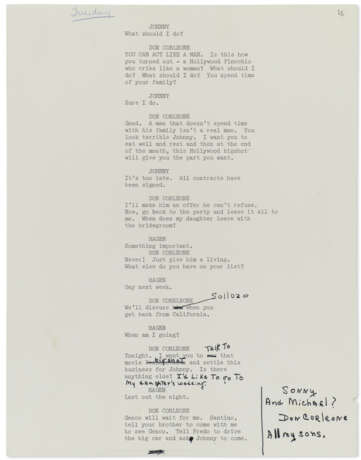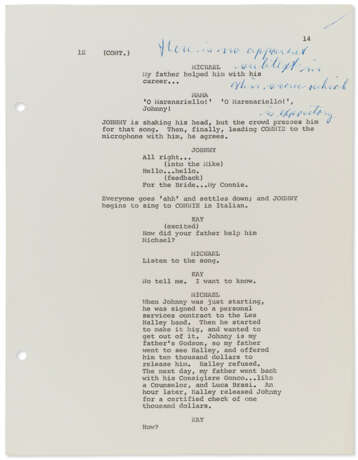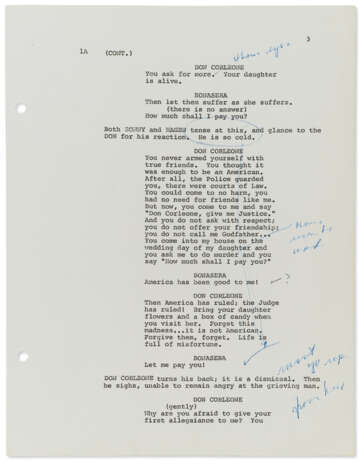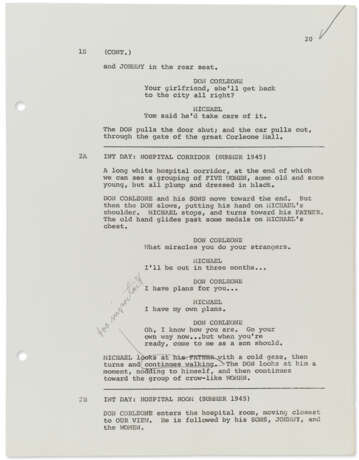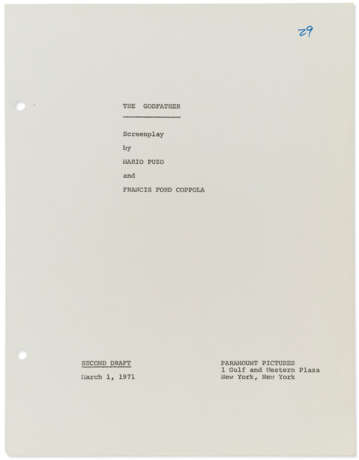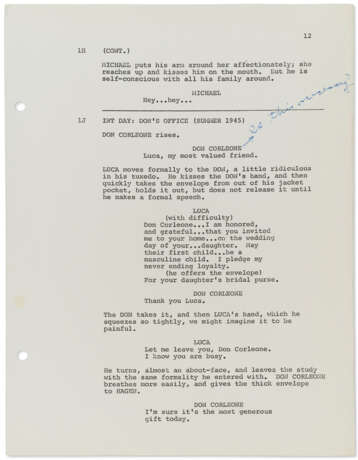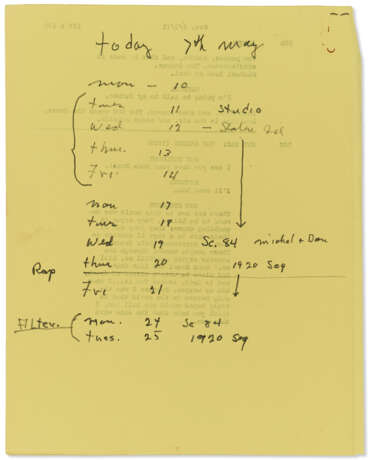ID 1360943
Lot 230 | Script edits for The Godfather
Valeur estimée
$ 20 000 – 30 000
66 pages, most 178 x 216mm, (with two larger pages, 355 x 216mm) with six pages edited in Brando's hand, on varying paper stock, some bundles stapled or paperclipped together with emendations primarily on rectos and occassional notes on versos (several pages with losses at left margins not affecting text, marginal tears and occasional soiling).
"Is this necessary?" Marlon Brando edits and comments on portions of the script of the 1972 classic, including key changes to the famous wedding scene, filmed in early May 1971. The archive consists of portions of several versions of the script beginning with the second draft dated 1 March 1971 and includes the title page together with pages 1-4, 8-20, and 38-39 where the majority of Brando's manuscript comments, accomplished in blue ballpoint can be found. On pages four and five he expresses his dissatisfaction with the opening scene when Bonasera begs Don Corleone to punish three men who had attacked his daughters. Brando suggests the order of dialogue be re-arranged significantly which is reflected in the final screenplay. In another instance, on page 12, Brando marks up his meeting with Luca Brasi beside his initial greeting, "Luca, my most valued friend," adding "Is this necessary?" While at first glance, the line questioned the line's necessity (which was eventually deleted) for his character. However a review of the final screenplay it is clear that Brando was adding that comment as a line, which is, in fact, a response to Hagen whispering to Don Corleone that Brasi wanted to see him, though he was "not on the list…" On page 14, during one of the outdoor wedding scenes where Michael Corleone is offering vague tidbits to Kay on his father's business, Brando writes: "There is no apparent subtext in this scene which is expository." Page 20 details an early draft of a scene that was ultimately deleted from the final cut: an encounter in the hospital which Don Corleone asks Michael about his plans when he left the Army, "I have my own plans," to which Don Corleone replies, "Oh, I know how you are. Go your own way now… but when you're ready, come to me as a son should." with that Michael stares at his father with a cold gaze and continues walking down the hall. Brando circled the last phrase in pencil, commenting that it was "too important."
Some changes can be traced between different versions of the script within the present archive, in one version, likley a draft from early May 1971, Brando (or possibly an assistant as the handwriting is lowercase print rather than his typical script), edits his conversation with Hagen (Robert Duvall) was supposed to fly to Hollywood to ensure that singer Johnny Fontane (Al Martino) was cast in a role he coveted ("I'll make him an offer he can't refuse…"). For the line, "Tonight. I want you to talk to that movie Pezzonovanta and settle this business for Johnny. Is there anything else?" Brando strikes out "Pezzonovanta substituting" it with "big shot" while adding another sentence: "I'd like to go to my daughter's wedding." Those revisions appear on several pages from a revision dated 3 May 1971 and was the line that appeared in the film.
Other comments are more practical including phone numbers for a "Dr. Goldsmith" apparently a "head master" which may relate to one of his children, as well as the address and phone number of photographer Gordan Parks. Most interesting perhaps, is a hastily-jotted shooting schedule for early May 1971 beginning with shooting in studio from 10-12 May, followed by the outdoor scenes for the wedding filmed on "Staten Isl[and]" as well as Scene 84 "Michael and Don" as well as the "1920s Seq[uence] through 24 May.
Although the script is far from complete, it offers a unique window into how Marlon Brando approached one of his most storied roles—a sentiment echoed by Susan Mizruchi, one of Brando's biographers, who wrote that the script was "revealing of Brando's intentions for the film…." (Typed letter signed to the consignor, Boston, 7 September 2013.) For additional information, see The Annotated Godfather: the Complete Screenplay. 50th Anniversary Edition. (New York: Black Dog & Leventhal Publishers, 2021). Provenance: Marlon Brando (his sale, Christie's, New York, 30 June 2005, lot 244.
| Lieu d'origine: | Etats-Unis |
|---|---|
| Catégorie maison de vente aux enchères: | Lettres, documents et manuscrits |
| Lieu d'origine: | Etats-Unis |
|---|---|
| Catégorie maison de vente aux enchères: | Lettres, documents et manuscrits |
| Adresse de l'enchère |
CHRISTIE'S 20 Rockefeller Plaza 10020 New York Etats-Unis | ||||||||||||||
|---|---|---|---|---|---|---|---|---|---|---|---|---|---|---|---|
| Aperçu |
| ||||||||||||||
| Téléphone | +1 212 636 2000 | ||||||||||||||
| Fax | +1 212 636 4930 | ||||||||||||||
| Conditions d'utilisation | Conditions d'utilisation | ||||||||||||||
| transport |
Service postal Service de messagerie ramassage par vous-même | ||||||||||||||
| Modes de paiement |
Virement bancaire | ||||||||||||||
| Heures d'ouverture | Heures d'ouverture
|
